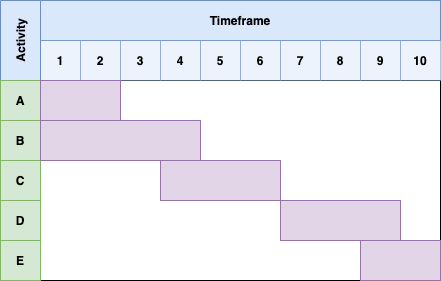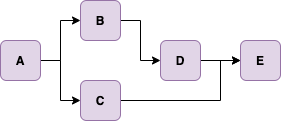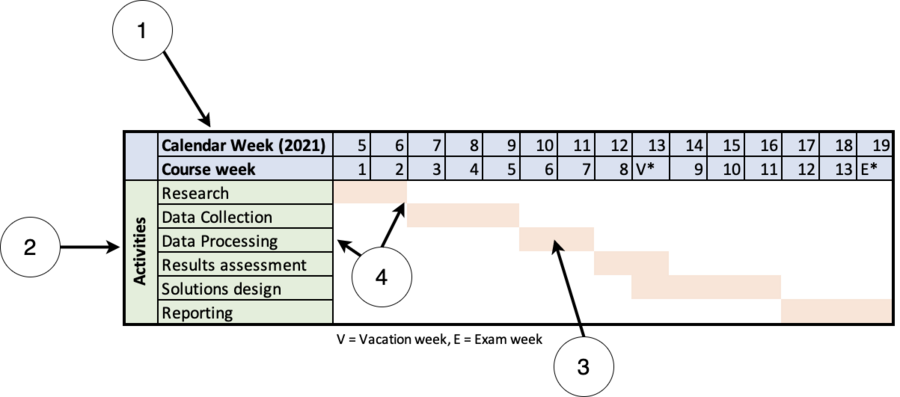Gantt Chart Scheduling
Contents |
Abstract
Gantt Charts are the foundation of planning and scheduling, thus perhaps being the most important element in project management. The Gantt Chart is a tool that allows managers to boil project parts and phases down to simple visual blocks based on the planned and expected duration, which can then be arranged according to interdependencies. Furthermore, as a visualisation tool, it provides overview of planned processes, in order for managers or stakeholders to keep track of what progress should be obtained at a certain point in a project.
This article sheds light on the overall concept of Gantt Charts, what they are used for and the relation to project management. As Gantt Charts are an almost inevitable scheduling tool when managing projects, it is also a key scheduling tool when using both the project management standard of the Project Management Institute[1] and Prince2[2].
As Gantt Chart Scheduling is a tool, the article suggests a guide of what to consider when using the tool, as well as how to apply it. The article suggests five key elements of Gantt Chart Scheduling, Scaling, Activities, Estimation, Relations. The Scaling element addresses who are using the Gantt Chart, the purpose of using it as well as the timeframe, in order to frame the scaling of the tool. The Activities represent the activities of the project, which are to be scheduled using the chart. The third element is estimating duration of the activities, followed by the Relations where interdependencies between activities are identified.
Gantt Charts are somewhat limitless with regards to the sizing and extent of the application, however, the chart itself does not solve scheduling issues. The article therefore addresses the limitations of Gantt Charts and challenges that may occur when applying them, as well as opportunities that stems from them.
Big Idea
The Gantt Chart was developed by Henry L. Gantt in the 1910s and the overall concept is to provide a visual overview of time, tasks and progress within a process consisting of a collection of activities. [3] Furthermore, the Gantt Chart is a tool to manage activities in relation to each other, in order to achieve a certain goal within a timeframe. Thereby Gantt Charts can be used as a tool for managing complexity in projects by scheduling project activities.
A Gantt Chart is a dynamic diagram that visualises scheduling of activities. The core elements of the Gantt Chart are horizontal bars representing activities of a given project. The length of the bars can represent the duration of the activity and the bars are placed according to their earliest possible start within the timeframe of the project. The earliest possible start of an activity is determined by its contingent relations to other activities. As Gantt Charts are a tool for managing activities, it is crucial to actively update the chart with real-time data, in order for activity progress or delay to be considered in the progress of related activities. If the chart is not updated accordingly, it simply shows an instant snapshot of the situation and progress of the project, at the time of creation.
The following figure shows an example of a basic setup of a Gantt Chart. The vertical axis consists of activities A-E, whereas the horizontal axis shows the timeline in an unspecified measure of time from 1-10. Furthermore, the purple boxes in each row indicates the scheduled start time, end time, duration and relation between the activities.
Gantt Charts are particularly useful in project management when managing time schedules and project activities. The British project management standard Prince2, suggests the use of Gantt Charts to present project schedules as well as an active stage plan. Furthermore, the standard encourages project managers to develop Gantt Charts for both the project plan and the team plan in order to respectively establish a tool for project control and assigning of deliveries.[2] Also the Project Management Institute suggests Gantt Charts as the tool for scheduling as well as project governance in their Guide to Project Management.[1]
Application
The following section describes how you as a project manager can create and use a Gantt Chart. In order to use Gantt Charts, there are several perspectives to consider. The core of the method can however be boiled down to the following four elements:
- Scaling
- Activities
- Estimation
- Relations
Each of the elements are described in the following sections. Furthermore, their relevans to project management is addressed as well as how to consider and apply them in project management.
Scaling
The first step of creating Gantt Charts is to consider its recipients and purpose, in order to determine the frame; both a visual frame for your chart and for you to scale the content. Therefore, you need to consider in what setting the tool is applied. The setting in which you are applying the tool impacts, how you should present the Gantt Chart. Is it for example only for personal use in a private setting, you might be able to settle on simplicity in your Gantt Chart; perhaps a drawn up version on paper or a spreadsheet.
However, if you on other hand are using the Gantt Chart in a professional setting, you ought to consider who is going to see, use and manage the chart. Are you for example using it in workshop with the project team? Then it might be useful to draw up the chart on board or a Flipchart, using post-its as activity blocks, that can be moved around throughout the workshop.
The chart might also be used actively throughout the lifetime of a project by several members of the Project Team. In that case, you ought consider where to place the chart, which will then impact the format. It might need to be placed on a company server or a joint platform, where all team members can access, edit and update the chart. In this case, the format could be a spreadsheet or perhaps even a dedicated project management software.
Furthermore, the chart might also be used as visualisation tool for the steering committee, project sponsors or other internal and external stakeholders. In that case presentation and clarity is crucial, as stakeholders outside the project team, might not have the necessary insights to understand the individual activities. Therefore, it must be considered how to present the chart to stakeholders, including clarify stakeholder expectations with regards to reporting and governance.
Additionally, this element includes determining the scale of timeframe, that the chart should cover. The perspective of time eventually determines the size of the chart, hence it also impacts the choice of application tool. It must therefore be considered whether, the project is time bound to a specific start and end date, thus these will frame the time of the chart. When considering the timeframe, you will also get an idea of what measure of time is applicable to the project, hence defining the size of the time blocks. If the project is for example running over the course of a few months, time and progress might be measured in days or weeks. Therefore, scale and time goes hand in hand, when initiating Gantt Chart Scheduling.
Overall you, as a project manager or simply user of a Gantt Chart, need to consider the purpose of the Gantt Chart, hence defining the setting. Furthermore, you must consider, who are the users of the chart and recipients of any information gained through the chart. These perspectives should give you an idea of where and how to develop and structure you Gantt Chart, by scaling the level of detail.
DTU Example
In order to show an example of how to scale a Gantt Chart with regards to a project, we consider an example of a project represented by the development and completion of a study and its deliverables for a university course at DTU.
The setting is the frame of the course, hence the creators of the chart is a group of students, that must work on a project throughout the course and finally deliver a report. The group is considered the project team and they will use the Gantt Chart to delegate assignments, represented as activities, and to estimate when to initiate the different activities in order to deliver the expected and required deliverables on time.
As the team members do not necessarily see and speak to each other on a daily basis, they decide to use a platform like Microsoft Teams, to store the Gantt Chart in a spreadsheet. On the platform all team members can access and edit the chart, so they are updated in between meetings. Furthermore, as the team is cooperating with an external company, they use the spreadsheet as a visualisation and governance tool of their progress, when meeting with their stakeholders, such as the company, teaching assistants and in course presentations.
With regards to the timeframe of the Gantt Chart, the group considers any boundaries of the course. As their course is a 5 ECTS-point course, running over 13 weeks during spring, they limit their Gantt Chart to start at the course start on approximately february 1st. As they know the duration of the course including vacation and examination periods, the end date in the Gantt Chart is set to approximately may 15th, which gives the team a total of 15 project weeks. Therefore, and also taking into consideration that the team will not speak on a daily basis, they decide on 'weeks' as their measure of time.
Activities
As the Gantt Chart is a way of structuring and scheduling tasks in relation to each other, you as the planner must identify and define activities. Within Project Management this is usually done in the scoping phase of the project, where for example a Work Breakdown Structure can be used to break down the project objective into doable activities or solvable tasks.
In your Gantt Chart, you want to schedule activities that are applicable to the recipients of the chart, thus using the Work Breakdown Structure, to define suitable activities. Depending on the level of scale of the Gantt Chart, the activities could represent everything from small tasks to larger parts or project phases. If the Gantt Chart is for example used to assign specific tasks to project team members, you might want the activities to represent actual actions. On the other hand, if the chart is used on higher level, where the project manager and project team schedules larger project parts, the activities might represent a collection of smaller tasks that as a whole provides a significant contribution to the project. When addressing stakeholder, the activities might even represent project phases or overall deliverables, without considering the actual content. Therefore, defining activities for the Gantt Chart is a matter of perspective, scaling and purpose.
DTU Example
Considering the team of students, that are running a project as part of their 13 weeks university course, the identification and definition of activities is also a matter of scale. Overall, their project is about proposing a solution to an unspecified problem in cooperation with their external partner. The deliverable for the course and thereby the project, consists of a final report, and the project therefore includes a number of different activities they must do throughout the 15 project weeks.
The project team has identified 6 major activities for which they want to monitor progress; Initial research, Collecting Data, Data Processing, Assessing Results, Solution design and Final reporting. However, as the group will only be communicating on a weekly basis, they decide to break down the activities to tasks, which they can then assign to individual team members to solve in between team meetings. The tasks vary from area to area, where the activity of Collecting Data is for example divided into activities of conducting a survey, doing an observation study and interviewing different stakeholders.
Estimation
In order to schedule the activities, a timespan or duration must be assigned to the activities. With regards to project management, duration is often the result of an estimation based on actual experience of project organisation members or organisational experience and data from previous similar activities.
The activities in the Gantt Chart should be assessed individually with regards to time. You can either try to estimate the expected duration yourself or seek insights from the team members that are expected to perform the necessary underlying tasks of the activities. Furthermore, if you for example working with the chart in an organisation, you might need to seek assistance from department managers from specific fields of interest or other project managers, in order to make a feasible estimation. In many cases estimation a guesstimate, however, by included data in the form of factual quantitative data or actual experience, the estimate will be closer to reality.
DTU Example
The team of students scheduling their project using a Gantt Chart must also estimate the duration of their identified activities. Most of the team members have attended similar courses before, and thereby worked on deliverables as projects with different tasks. The team goes through the list of tasks; they each propose a feasible duration of the task and agrees on time boxing each of activities to individual timespans. In their estimation of the activities of the data collecting phase, they decide on estimating the conducting of their survey to a total of two weeks, whereas both the observation study and interviewing process are estimated to one week each.
Relations
The last yet very important element of Gantt Chart Scheduling is identifying and managing the relation between activities. In general, a relation exists if a task cannot for example be commenced or finished before or until another specific task has been fulfilled. This is the essence of Gantt Chart Scheduling, as the relations determines when the different activities can be conducted, hence controlling the time of the final delivery and the overall duration.
Furthermore, external factors can have an impact on the commencement, fulfilment and duration of activities. An example of an external factor is weather or temperature, which could dictate that a project should be conducted at a certain time of year. Also politics, legislation, funding, global or national crisis amongst others, can have an impact on the relations between activities.
Another factor of implication could be the amount of available and ascribed project resources. Therefore, the Relations element of Gantt Scheduling also contains prioritisation of activities with regards to time of commencement.
In order to identify potential interdependencies, you need to assess each activity and determine whether the activity can be commenced and fulfilled regardless of the progress of any other identified activity. Once you have identified an activity that does not rely on other activities, you can assess all other activities in relation to the first determine which activities depend on this. This exercise can then be performed until all activities have been assessed. The relation can simply be illustrated with a hierarchy, where arrows indicates relations and the placement from left to right represents the order of completion. The following figure represents a simple version of such dependency hierarchy with activities A-H.
The figure shows that activity B and C are dependent on activity A, and cannot be commenced until A is finished. D on the other hand only relies on the completion on dependency and the last activity E can be commenced at the completion of C and D. This hierarchy can then be used to schedule the Activities in a Gantt Chart.
DTU Example
When investigating the interdependencies of the activities in their project, the team finds that they can for example not initiate their activities of collecting data, until they have conducted their initial research on the topic. Furthermore, they discover that the stakeholder interviews cannot be conducted until their survey and observation study have been fulfilled, hence making causing an interdependency between the interviews, the survey and observation study. In their investigation of relations, they also consider the Covid-19 Pandemic as factor to be aware of throughout their project, as some activities might be delayed or even cancelled due to crowd restrictions.
Core elements
The following figure shows a basic setup of a Gantt Chart containing the four core elements of Gantt Chart Scheduling, for the DTU example.
Explanation:
- Scaling: The Gantt Chart is represented in a spreadsheet with the timeframe limited to the 15 project weeks and on a presentation level.
- Activities: As the the chart is on a presentation level it shows the six overall activities of the project team.
- Estimation: The size of the orange boxes indicates the estimated duration of the activities. The Chart thereby shows that the Research activity is estimated to two weeks, Data collection to 3 weeks and so on.
- Relations: The intersection between the activities as well as their placement in the activity list indicates interdependencies.
Overall, the Gantt Chart is read from top left corner to bottom right, as the top activity is usually the initiating activity. You can then follow the duration boxes from left to right, to see when the different activities are scheduled to commence.
The Gantt Chart in the figure above only represents a simple version. Other charts may have a large range of different features, which may provide additional analytical indicators or automation assistance. The number of features is impacted by scaling and thereby choice of Gantt Chart tool; whether it is a simple Flipchart, a specialised Project Management Software or something else.
Limitations
Who, Where and When
If you do not update, then it just shows where you left it. It is not automized – can however be automized, in some cases
Annotated bibliography
1. In Prince2 2. In PMI 3. In Large Scale Projects 4. In Excel


